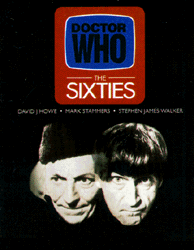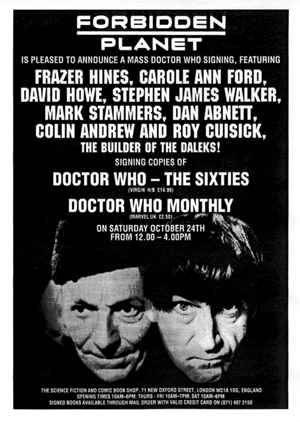The Sixties

The story of Doctor Who: The Sixties actually starts with a completely different book. Through my writing for Doctor Who Magazine and publishing The Frame, I had kept in fairly close contact with the various editors at W H Allen (as it was then) and when Peter Darvill-Evans took over, the good relationship I had established remained strong and if anything became even stronger.
In the first nine issues of The Frame, we had run a series of articles called 'Dalek Design' which, as the name suggests, chronicled the look of those metal monsters through their many appearances on television. These had been widely acclaimed by our readers and I suggested to Peter one day that it would be a nice idea to take and update all the existing material, add some information on the films and some new photographs, and compile a definitive guide to the Daleks. He liked the idea and so did the BBC. There was one further hurdle to overcome: Terry Nation's agent Roger Hancock.
Doctor Who: Daleks actually reached the draft contract stage before Roger Hancock faxed Peter at the eleventh hour (we were due to sign the contracts the following day!) to say that they could not agree to the project because of a clause in Terry Nation's contract with St Martin's Press in America for The Ultimate Doctor Who and the Daleks Book which effectively prevented him from writing or allowing any similar work. They felt that our idea was similar and so we couldn't do it!
To say were were disappointed would be an understatement. However, Peter said that he liked our work in The Frame, and the ideas behind Doctor Who: Daleks were good and so he still wanted us to do something. We came up with about a dozen ideas, and after discussing them through with Peter, combined several into a format which was to become The Sixties. As an aside, it was through discussions with us that Peter decided to release the new hardbacks in a sort-of series, so that there would be Doctor Who: Daleks, Monsters, Gallifrey and so on. The Sixties fitted in with this theme and so the title stuck. I don't know why Gallifrey was retitled to The Gallifrey Chronicles.
Back to the plot. Our intention was to delve behind the scenes and to put together a definitive history of the making of Doctor Who in the sixties as, despite a few features in Doctor Who Magazine and other fanzines, it had never been done properly before. Of course there was Jeremy Bentham's Doctor Who: The Early Years, but that only covered the work of one designer, and other factual material about that period tended to be full of accumulated fan speculation, misinformation and suspect memories. No-one had actually gone out and done the research before and that was our aim.

An early cover concept for the book.
We were helped in this because both Stephen and myself had been involved in fandom since the mid-seventies and had spent that time collecting and keeping as much as we could about the programme. Stephen in particular had gained access to numerous BBC files and had accumulated much information about the origins of Doctor Who.
To try and detail the step-by-step writing of the book would be impossible, but we determined early on that we would try not to go from previously printed interviews if at all possible. We therefore re-interviewed many people involved with the period, and combined this with the interviews we had already done for The Frame over the years. As well as these, we gained permission to use material from both Doctor Who Magazine and Dream Watch Bulletin. We also were able to secure other sources of information within the BBC, including access to all the merchandise files to try and work out once and for all what had been produced to tie in with the programme.

An early unused logo design for the book.
All this wealth of data was then compiled together and rationalised, so that previous mistakes could be removed and true facts instated. The end result is a book which hopefully presents a consistent and logical history of Doctor Who. We are fairly confident that Doctor Who: The Sixties will not be contradicted on any point of fact, but that if more information comes to light, it will back up what we have presented. Of course if we are proven wrong, then we intend to include corrections in any future books in the series.
The writing of a book like The Sixties is only a small part of the whole. The other side of the coin is the illustrations. Here we benefitted from Steve and myself's magpie instincts and many of the photos come from our accumulated collections. Other photos were tracked down through patience and some luck. Derek Martinus came up with a couple of stills from Galaxy 4 which have never been seen before, Robert Jewell provided some rehearsal shots from The Daleks' Master Plan, the designer John Wood had some photographs from The Celestial Toymaker and also material from The Space Pirates and the wonderful Barry Newbery and Raymond Cusick were generous to a fault in their loan of photogaphs and designs.
In all Mark (who did all the design and layout on the book himself) managed to cram in over 400 photographs, which, when you consider that The Gallifrey Chronicles only contained 100 photographs, is some feat. Our original intention of presenting at least one rare or unpublished photo from every story was not met - it was impossible to track down any new material from some stories - but we came pretty close.

A poster idea.
As part of our unwritten brief to leave no stone unturned, the book also contains brief biographies of every Producer, Director, Writer and Companion plus several others. There are newspaper cuttings and assorted information on everything from the music to the locations through the studios used for recording. I think we can safely say that if it happened in the sixties then there is some reference to it in the book.
A final aspect which particularly pleased me was that we were able to include an index at the back - the first factual Doctor Who book to do so. This means that you can actually look things up quickly and easily and the book becomes a true reference work.
I hope that everyone who sees the book will enjoy what we have put together. It took a lot of time and a lot of love and care and I hope that the results reflect that.

A flier for the launch signing at London's Forbidden Planet bookstore.